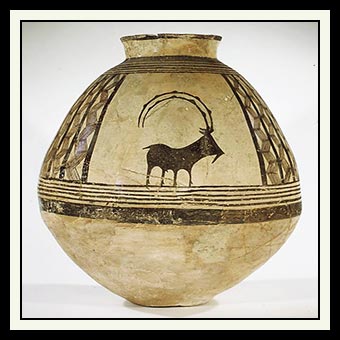About the Persian handmade Pottery.
History of the Iranian handmade ceramic:

Undoubtedly, most parts of the Iran were the center of handmade Ceramic and pottery production. According to the latest archaeological survey, pottery making in Iran started from 8th millennium B.C. During the Historical Periods: Achaemenes, Parthian & Sassanian, pottery production was common mainly in their political center and famous cities. In the early Islamic period, the production of ceramics such as Polychrome, Slip-painted, Black-on-white and Luster potteries was common.
By the beginning of the 10th century A.D., the potters of Gorgan had introduced new types of ceramic, the sgraffito and carved wares. These types were first decorated with simple geometric and floral designs, and later by human and animal designs. Under the influence of national epics such as the Shahnameh of Firdausi, the decoration of sgraffito, carved and molded wares with motifs taken from these epics became popular.
The Seljuk period was the beginning of the golden age of ceramic manufacture in Iran. Nearly all type of pottery was made, among which Luster painted, under glaze painted, and molded wares deserve special mention.
The production of this period called ” Seljuk fine ceramic” became popular. During the short period of the Khwarazm shah, Persian pottery production reached its highest degree of magnificence. In this period is found information about the place and date of manufacture, and sometimes the signature of the pottery artist. In the early 13th century A.D., Iran was destroyed by the Mongols, but recovered under the Il-Khanids. Pottery of this period restarted using a combination of Mongol and Persian style.
The painted potteries of this period were made with thin Bodies, and simple decoration on pottery. During the later IL-Khanid and Timurid periods, there also appeared new types of pottery such as Blue & White and celadon wares.
The Safavid period was a renaissance in the history of Iranian pottery, and body of Safavid pottery was so fine, thin and translucent, that it comes much closed to the imported Chinese porcelain. Safavid pottery styles included: Kubachi, Lustre, Gombroon, blue and white, Monochrome and polychrome.
The Pottery of Zand & qajar poeriod: In this period the capital removed from Isfahan, first to Shiraz under the Zand, and then to Tehran under the Qajars. Architectural and tiles decorated of Zand is visible in mosques and other buildings in Shiraz. Then Tile production continued in Tehran, pottery & tile of qajar period depict more human figures in dark blue back ground. The tiles painted of Qajar period are visible in Tehran palaces.
Isfahan produced a kind of blue and white and an unglazed polychrome-painted ware throughout the 19 century. Towards the end of the century there was a general decline in pottery manufacture in Iran, due mainly to the mass imported and cheaply produced industrial porcelain from Europe and the Far East, this meant the end of artistic pottery production in Iran.
The most important stage in the production of Iranian pottery is painting and decoration. For this reason, the Iranian artist likes to decorate his pottery with human, animal, bird, geometric designs and other paintings, so that we can see that Iranian artworks are very beautiful and valuable in the art world.
Dear visitor, if you are interested in Iranian pottery, you can visit the collection of potteries, which has been created by an iranian artist.
please click this: The collection of Iranian potteries.
© KHorshid Artworks Collection.
